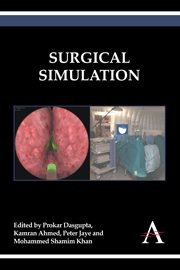Book contents
- Frontmatter
- Contents
- 1 Surgical Simulation: An Overview
- 2 Simulation in Historical Perspective: The History of Medical and Surgical Simulation
- 3 The Role of Animal Models in Surgical Training and Assessment
- 4 Full Procedural Surgical Simulation
- 5 Developing Non-technical Skills
- 6 Learning Curves for Simulators
- 7 Developing a Simulation Programme
- 8 Patient Safety and Simulation
- 9 Psychometrics
- 10 Future of Surgical Simulation
- Author Details
8 - Patient Safety and Simulation
Published online by Cambridge University Press: 05 April 2014
- Frontmatter
- Contents
- 1 Surgical Simulation: An Overview
- 2 Simulation in Historical Perspective: The History of Medical and Surgical Simulation
- 3 The Role of Animal Models in Surgical Training and Assessment
- 4 Full Procedural Surgical Simulation
- 5 Developing Non-technical Skills
- 6 Learning Curves for Simulators
- 7 Developing a Simulation Programme
- 8 Patient Safety and Simulation
- 9 Psychometrics
- 10 Future of Surgical Simulation
- Author Details
Summary
Introduction
Patient safety remains a major focus of modern healthcare. The US Institute of Medicine (IOM) report, To Err is Human: Building a Safer Health System, suggested that deaths due to medical errors exceed the total number of fatalities reported from motor vehicle accidents, breast cancer or AIDS, respectively (1). Some of the issues identified in this report could be addressed by adequately training the workforce in question. Training has traditionally always been acquired whilst treating live patients via the implementation of an ‘on-the-job apprenticeship’ model. This is unsatisfactory and has become virtually obsolete in the modern educational curriculum. Emphasis should therefore be laid upon initially training novices prior to their interaction with live patients in a patient-free environment using simulation, which risks no harm to patients.
Education has traditionally focused on imparting the knowledge necessary to practise medicine. However, modern training systems focus on the parameters of acceptable clinical practice within the framework of patient safety. Healthcare delivery is fast changing, especially with the introduction of new techniques in surgical practice. This highlights the importance of both a lifelong learning process and the introduction of simulation technology. Simulation is “a technique to replace or amplify real patient experiences with guided [experience that artificially] replicates substantial aspects of the real world in a fully interactive manner” (2). Simulation is designed to address the fast-changing needs of healthcare by providing a mosaic of technical and nontechnical skills in a crawl–walk–run approach.
- Type
- Chapter
- Information
- Surgical Simulation , pp. 85 - 94Publisher: Anthem PressPrint publication year: 2014

